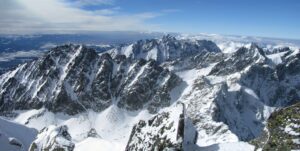When one thinks of towering peaks, Asia, Africa, or Europe might come to mind. Yet, North America, spanning vast distances and encompassing 23 countries with diverse biomes, presents awe-inspiring summits. Far from being dominated solely by the expansive Great Plains, this continent showcases some of the world’s highest mountains, enriching its geographical canvas.
The continent’s scenic vistas are defined by its captivating mountains, and Alaska, with its isolated and rugged landscape, boasts the most significant number of eminent peaks in North America. Despite their remoteness, making them less visited, these mountains are a testament to Alaska’s distinctive geography. To the east, the age-old Appalachians cast their enduring shadow.
In contrast, the west showcases younger mountain ranges that house North America’s loftiest points, including The Rockies, Cascades, and the Sierra Madre. These form the extensive American Cordilleras, a continuum from the Isthmus of Panama to Canada. The question of which peak reigns supreme in North America evokes tales of thrilling mountaineering expeditions.
Climbing these heights is seen by many as a mark of endurance against the grandeur of nature. The U.S. alone has ninety-two peaks exceeding 14,000 feet (4,200m), and Canada’s highlands offer their distinct challenges. Ranges like the Rocky Mountains, Cascade Range, and Sangre de Cristo Mountains hold captivating stories. Exploring these mountains promises an unforgettable journey, demanding grit and determination in light of nature’s beauty.
North America’s 20 Tallest Mountains
| No. | Mountain Name | Elevation (meters) | Elevation (feet) | Mountain Region |
|---|---|---|---|---|
| 1 | Denali (Mount McKinley) | 6190.5 | 20,310 | Alaska Range |
| 2 | Mount Logan | 5959 | 19,551 | Saint Elias Mountains |
| 3 | Pico de Orizaba | 5636 | 18,491 | Cordillera Neovolcanica |
| 4 | Mount Saint Elias | 5489 | 18,009 | Saint Elias Mountains |
| 5 | Volcan Popocatepetl | 5410 | 17,749 | Cordillera Neovolcanica |
| 6 | Mount Foraker | 5304 | 17,400 | Alaska Range |
| 7 | Mount Lucania | 5260 | 17,257 | Saint Elias Mountains |
| 8 | Iztaccíhuatl | 5230 | 17,159 | Cordillera Neovolcanica |
| 9 | King Peak | 5173 | 16,972 | Saint Elias Mountains |
| 10 | Mount Bona | 5044 | 16,550 | Saint Elias Mountains |
| 11 | Mount Steele | 5020 | 16,470 | Saint Elias Mountains |
| 12 | Mount Blackburn | 4996 | 16,390 | Wrangell Mountains |
| 13 | Mount Sanford | 4949 | 16,237 | Wrangell Mountains |
| 14 | Mount Wood | 4860 | 15,945 | Saint Elias Mountains |
| 15 | Mount Vancouver | 4812 | 15,787 | Saint Elias Mountains |
| 16 | Mount Slaggard | 4742 | 15,558 | Saint Elias Mountains |
| 17 | Nevado de Toluca | 4690 | 15,387 | Cordillera Neovolcanica |
| 18 | Mount Fairweather | 4671 | 15,325 | Saint Elias Mountains |
| 19 | Mount Hubbard | 4557 | 14,951 | Saint Elias Mountains |
| 20 | Mount Bear | 4520 | 14,831 | Saint Elias Mountains |
1 Denali Mountain, the Tallest Mountain in North America
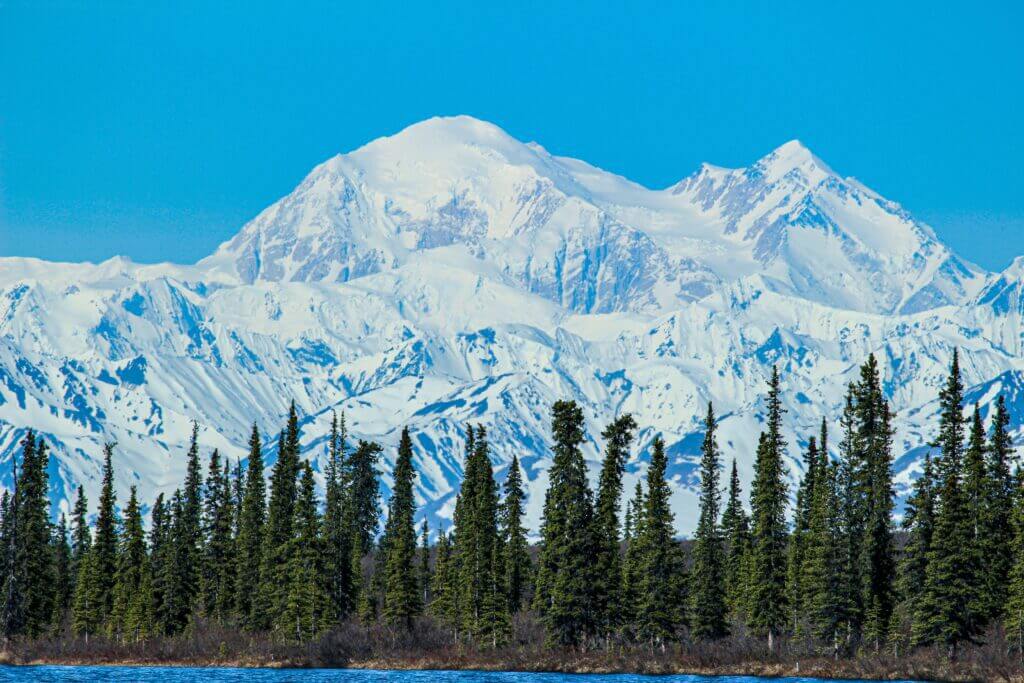
Elevation: 6190.5 m (20,310 ft)
Mountain Region: Alaska Range
Towering at 20,310 feet, Denali (Mount McKinley) is a monolithic gem in the crown of North America’s highest mountain peaks.
Situated in Alaska, this majestic mountain is a crucial feature of the Grand Alaska Range. Moreover, it is a pivotal centrepiece of the Denali National Park and Preserve. Its snow-capped summit and rugged terrains testify to nature’s awe-inspiring beauty and power.
Mount McKinley’s lofty stature extends beyond the borders of North America. Besides being the highest peak in the United States, it is North America’s tallest mountain. Moreover, its grandeur on a global scale is further cemented as it is the third tallest mountain in the world. Thus, Denali is not merely a mountain but an adventure and exploration epic tale. It is a beacon calling to those with a spirit for adventure willing to scale its imposing height. It embodies Alaska’s raw, unbridled beauty and stands as a symbol of the monumental grandeur that North America’s landscapes offer.
2 Mount Logan
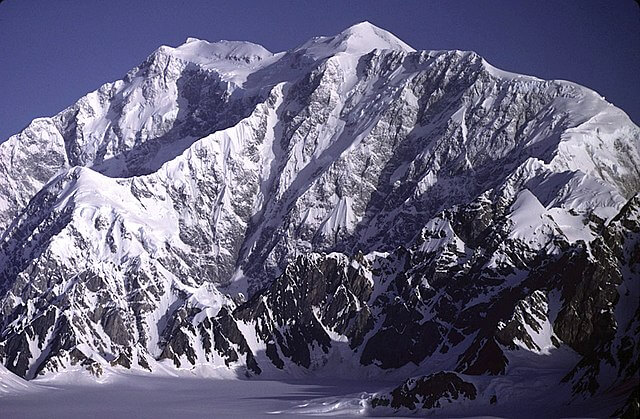
Elevation: 5959 m (19,551 ft)
Mountain Region: Saint Elias
Mountains Nestled in the Saint Elias Mountain Range in the Yukon Territory of Canada, the awe-inspiring Mount Logan soars as the second-tallest peak in North America. With an elevation of 19,551 feet, it is a towering testament to the continent’s natural splendor and diversity. Mount Logan is more than just a mountain; it is a living, breathing entity of the Earth’s dynamic crust.
Unlike most other peaks, it defies the traditional notion of static grandeur. Tectonic plates’ continuous shifting and grinding beneath this colossal mass lead to its gradual yet persistent growth. Every day, it reaches just a little higher towards the sky, silently shaping and reshaping itself in the ceaseless dance of geological forces. The mountain finds its home within the vast wilderness of the Kluane National Park and Reserve. As a central feature of the park, it contributes significantly to the ecological tapestry of the region.
It offers a habitat to diverse species and adds depth to the visual and experiential panorama of the area. Consequently, Mount Logan isn’t just a towering peak. It is a compelling illustration of the ever-evolving story of our planet. Moreover, it is a wonder that invites exploration and respect for the unstoppable forces of nature that shape our world.
3 Pico de Orizaba
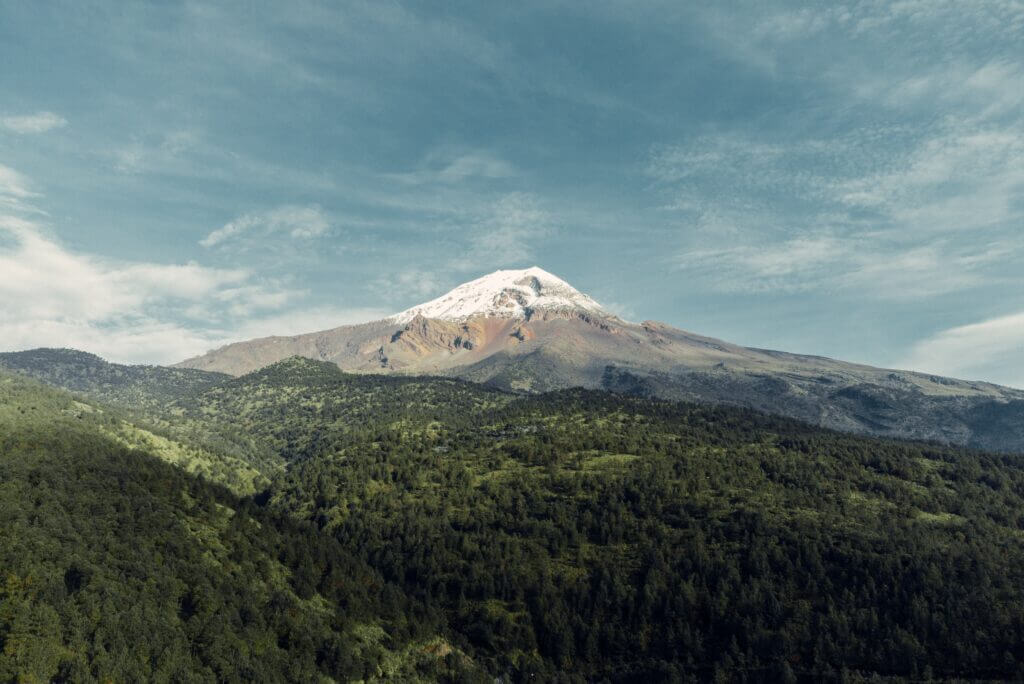
Elevation: 5636 m (18,491 ft)
Mountain Region: Cordillera Neovolcanica
Gracing the Cordillera Neovolcanica mountain range on the border of the Mexican states Puebla and Veracruz, Pico de Orizaba, or Citlaltepetl as it is also known, holds the distinction of being the third highest peak in North America.
Ascending to an impressive 18,491 feet, this mountain is a testament to the diversity of North America’s natural wonders. Its volcanic nature truly sets Pico de Orizaba apart from other high-altitude destinations. Despite being dormant, this volcano is a tangible reminder of the dynamic forces that shape the Earth. Its last eruption in 1846 is a powerful echo of its fiery past, when it spat fire and molten lava, reshaping the surrounding landscape and the lives of those living nearby.
Today, Pico de Orizaba’s quiescent status offers adventurers and nature enthusiasts an exceptional opportunity. Its snow-capped peak provides a serene contrast to its fiery past and invites those with a spirit of exploration to discover its mysteries. With every step taken towards its summit, climbers face a physical challenge and journey through a captivating geological narrative, witnessing firsthand the dichotomy of tranquillity and turmoil that defines this magnificent mountain.
4 Mount Saint Elias
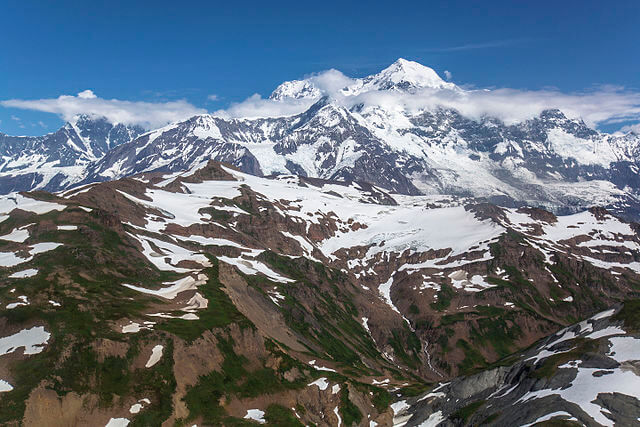
Elevation: 5489 m (18,009 ft)
Mountain Region: Saint Elias Mountains
Situated within the Saint Elias Mountain Range alongside Mount Logan, the fourth tallest mountain in North America is Mount Saint Elias, an impressive peak scaling 18,009 feet. This geographical titan uniquely straddles two territories – the United States and Canada, making it a symbol of shared natural grandeur.
Marking the boundary between Alaska in the United States and the Yukon Territory in Canada, Mount Saint Elias finds its residence split between two iconic National Parks. The northern slopes of the mountain grace Canada’s Kluane National Park and Reserve, contributing to its scenic splendour and diverse landscapes. On the southern side, the Alaskan part of the mountain is encompassed by the Wrangell-Saint Elias National Park and Preserve in the United States, adding to the park’s diverse ecological tapestry.
This unique positioning provides Mount Saint Elias with an unparalleled allure, standing as a sentinel over the landscapes of two nations. Adventurers scaling this peak test their mettle against its heights and journey across two distinct yet interconnected ecosystems. Therefore, Mount Saint Elias is not just a physical peak but also a symbol of the shared natural heritage of North America, a beacon of unity amid grandeur.
5 Volcan Popocatepetl
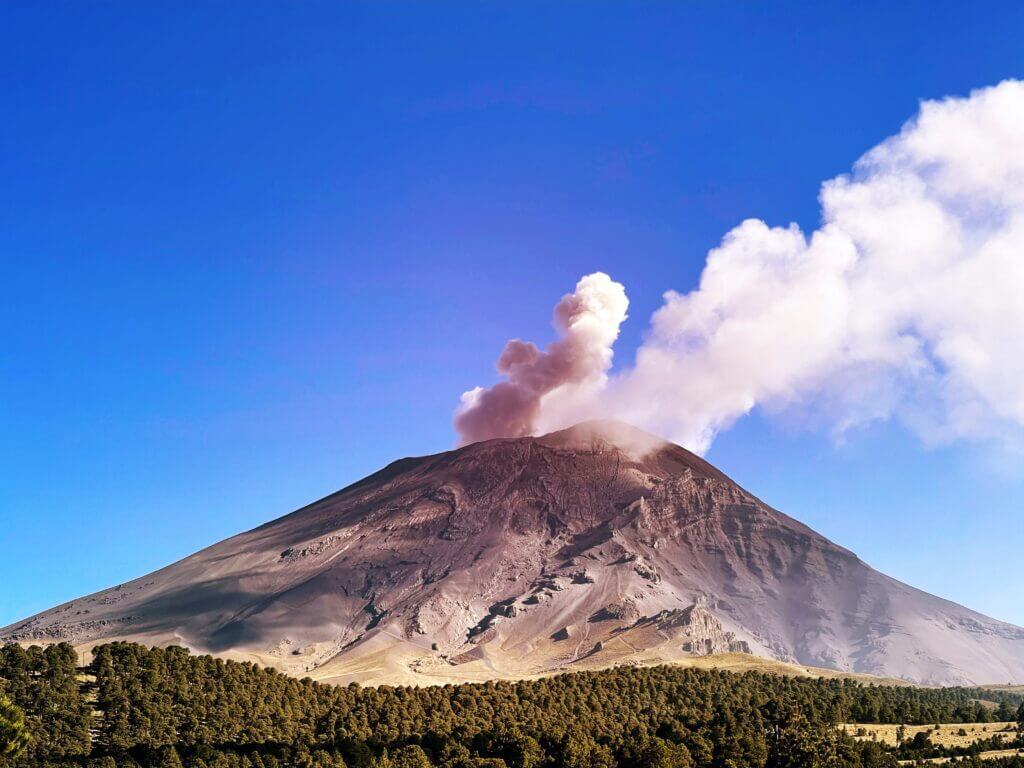
Elevation: 5410 m (17,749 ft)
Mountain Region: Cordillera Neovolcanica
Rounding out the top five tallest peaks in North America is Volcan Popocatepetl. Nestled within the confines of the Cordillera Neovolcanica range, it stands proud at an elevation of 17,749 feet. The mountain graces the borders of Puebla, Morelos, and the State of Mexico, adding an awe-inspiring silhouette to these regions’ landscapes. Yet, the grandeur of Volcan Popocatepetl goes beyond its towering stature.
As an active volcano, it is a simmering testament to the raw and ever-changing power of the Earth. Its last eruption in 1947 is a vivid reminder of the life and energy beneath its craggy exterior, a pulsating heart of molten rock waiting for the next moment of explosive release. Despite the inherent danger of its volcanic activity, Volcan Popocatepetl is a captivating site.
It represents a pinnacle of natural wonder, a vivid example of the Earth’s geological dynamism. For those drawn to the untamed forces of nature and the lure of high-altitude adventures, Volcan Popocatepetl is an unforgettable destination, a testament to the audacious spirit of explorers and the enduring allure of North America’s tallest peaks.
6 Mount Foraker – Alaska
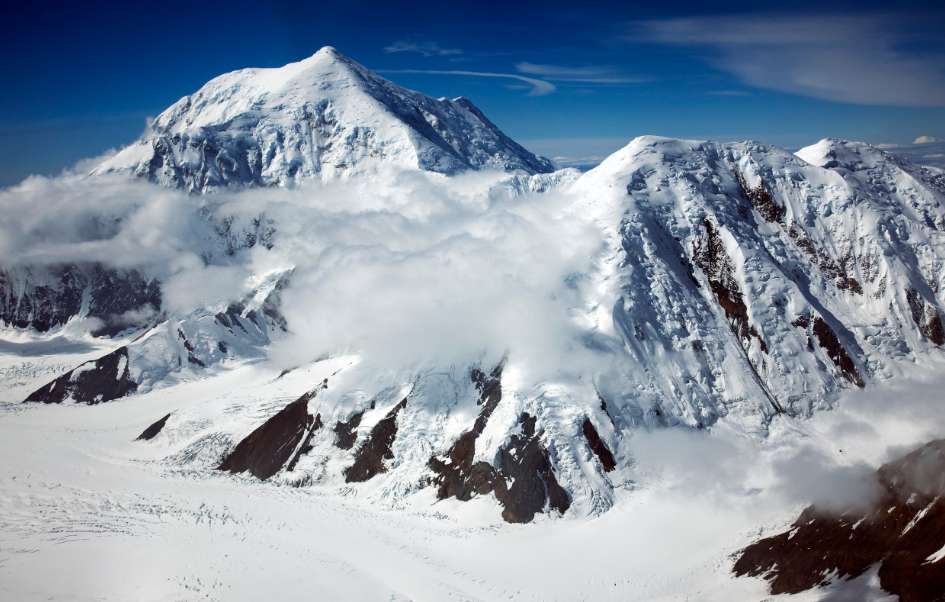
Elevation: 5304 m (17,400 ft)
Mountain Region: Alaska Range
Mount Foraker stands proudly as the third-highest peak in the United States, reaching a height of 17,400 feet among the scenic vistas of the Alaska Range. On a day of clear skies, it can be seen keeping vigil alongside Denali, the highest peak in North America, creating a majestic silhouette against the Alaskan sky.
Mount Foraker is located within the Denali National Park and Preserve, approximately 14 miles southwest of Denali. Its location on a fork of the Kahiltna Glacier, the longest glacier in the Alaska Range, makes it a fascinating spot for those seeking to witness the unique interplay between geological forces and icy grandeur. Mount Foraker is steeped in local cultural significance as well.
The indigenous Dena’ina people know it as “Sultana” or “Menlale”, which means “the woman” and “Denali’s wife”, respectively, a nod to its proximity to Denali. The history of mountaineering at Mount Foraker is also rich, with the first recorded successful summiting of its north and south peaks dating back to 1934.
The team of Charles Houston, T. Graham Brown, and Chychele Waterston achieved this feat, setting a milestone in the annals of climbing history. Mount Foraker offers natural beauty, cultural significance, and adventurous allure. Its imposing presence is a challenge for climbers, a fascinating subject for geologists, and a symbol of natural grandeur for all who gaze upon it.
7 Mount Lucania
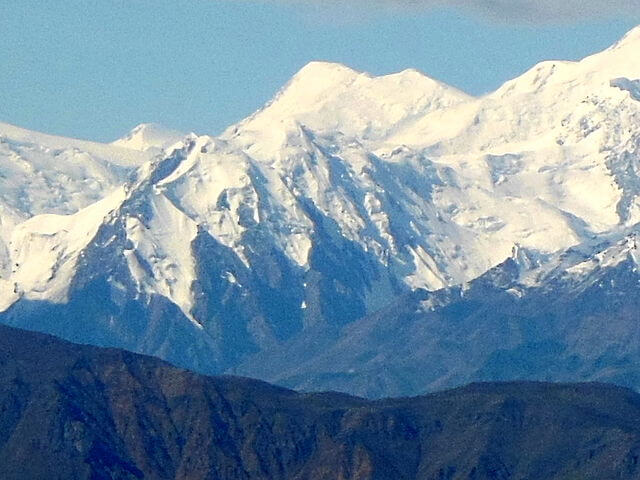
Elevation: 5260 m (17,257 ft)
Mountain Region: Saint Elias Mountains
Ranked as the seventh-highest mountain in North America, Mount Lucania paints a striking picture against the backdrop of Canada’s Yukon territory. Ascending to a height of 17,257 feet, its grandeur is intricately woven into the Yukon’s mountainous tapestry.
Linked to Mount Steele by an extensive ridge, these two colossal formations create an awe-inspiring sight, evoking a sense of adventure in the hearts of climbers and nature enthusiasts alike. Mount Lucania is proudly Canada’s third-highest peak and the country’s second-highest peak entirely. Its remarkable prominence on the continent is unquestionable. Its name is a tribute to the RMS Lucania, chosen by the Duke of Abruzzi.
He reached the summit of Mount Saint Elias in 1897 for the first ascent. While looking at Mount Lucania from afar, he saw a suitable namesake in the ship that took him from Liverpool to New York. The tale of human endeavor on Mount Lucania dates back to 1937, marking the first successful ascent.
Today, the mountain continues to captivate visitors, its formidable height standing as an enduring symbol of North America’s rugged natural beauty and the ceaseless allure of the Canadian Yukon.
8 Iztaccíhuatl
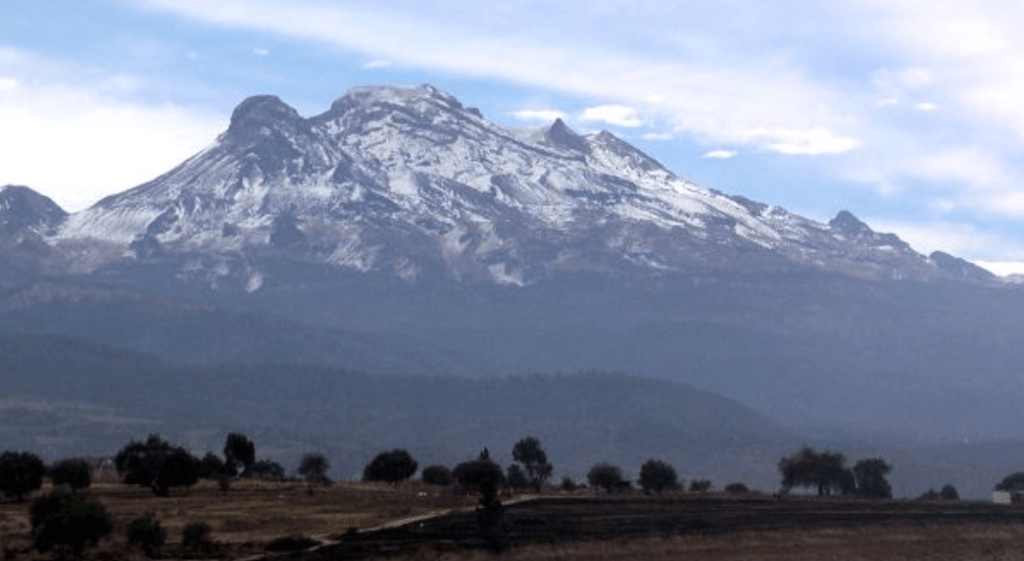
Elevation: 5230 m (17,159 ft)
Mountain Region: Cordillera Neovolcanica
Gracing the sky at an impressive elevation of 17,159 feet, the dormant volcano Iztaccíhuatl is one of Mexico’s most captivating natural wonders. Located on the border between the State of Mexico and Puebla, within the bounds of Izta-Popo Zoquiapan National Park, Iztaccíhuatl is ranked as the nation’s third highest mountain, trailing only Pico de Orizaba and Popocatépetl.
Iztaccíhuatl, a name from the Nahuatl language meaning “White Woman”, is uniquely characterized by its four snow-capped peaks. From the east or west, these summits artistically depict the silhouette of a sleeping female, revealing the head, chest, knees, and feet. This fascinating mountain, adorned with permanent snow and glaciers, is the twin of Popocatépetl to the south, with the two connected by the high-altitude Paso de Cortés. As an imposing presence on the Mexican skyline, Iztaccíhuatl can often be viewed from Mexico City, about 43 miles north-northwest mountain.
Climbers and explorers first etched their triumph over this monumental peak in the annals of recorded history in 1889. However, archaeological findings suggest that the Aztecs and other earlier cultures may have scaled their heights even before this time. Iztaccíhuatl thus remains a significant landmark in Mexico, its towering height and mesmerizing silhouette a testament to the country’s rich topography and cultural heritage.
9 King Peak
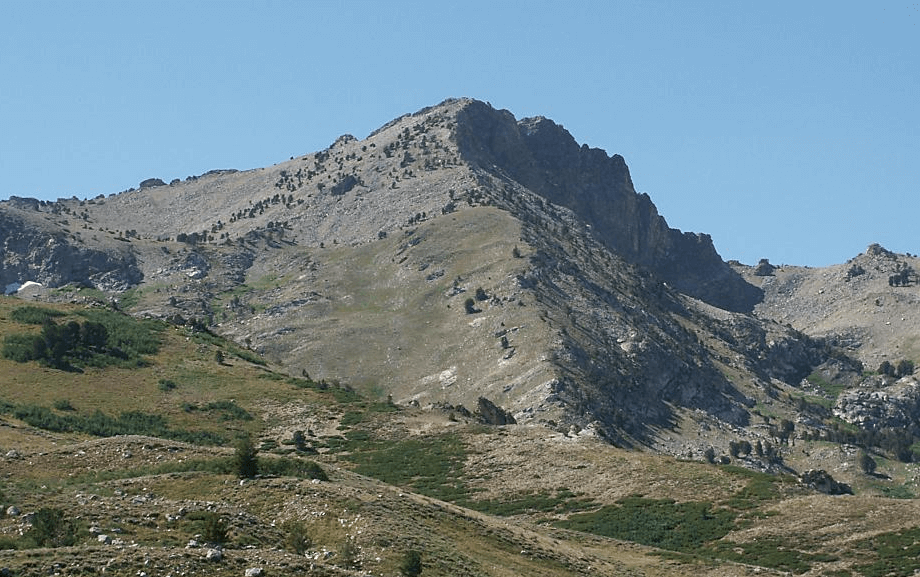
Elevation: 5173 m (16,972 ft)
Mountain Region: Saint Elias Mountains
Nestled in the vast expanse of Yukon, Canada, the towering majesty of King Peak captivates those fortunate enough to witness it.
King Peak is the ninth-highest mountain in North America and the fourth-highest in Canada, a testament to the country’s abundant natural beauty and diverse landscape. This colossal peak, sometimes called Mount King, is situated just west of the highest mountain in Canada, Mount Logan, and is often considered a satellite peak of its more prominent neighbour. King Peak’s rugged slopes and magnificent stature were first conquered on June 6, 1952, by a group of dedicated students from the University of Alaska.
Today, the towering height of King Peak continues to inspire awe and beckon the adventurous. Its enduring grandeur underlines the raw, captivating allure of North America’s alpine landscapes, highlighting the vibrant tapestry of peaks that dot the continent.
10 Mount Bona
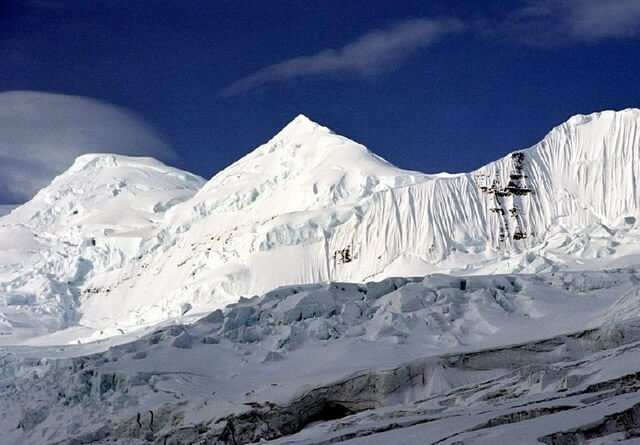
Elevation: 5044 m (16,550 ft)
Mountain Region: Saint Elias Mountains
Situated in the rugged landscapes of eastern Alaska, Mount Bona is the fifth-highest peak in the United States. Additionally, it also ranks the tenth-highest in North America.
This stratovolcano is also the highest in the United States and the fourth-highest in North America. It also forms part of the majestic Saint Elias Mountains. Cloaked almost entirely in ice fields and glaciers, Mount Bona is a natural sculpture of ice and rock.
This presents an imposing presence on the landscape. Moreover, the icy mantle makes it a significant source for the Klutlan Glacier, which snakes east for over 40 miles into the Yukon Territory of Canada. In addition, Mount Bona contributes a considerable volume of ice to the north-flowing Russell Glacier system.
This is a testament to its role in shaping the region’s geography. The first ascent to Mount Bona’s summit was accomplished in 1930 by Allen Carpé, Terris Moore, and Andrew Taylor. They undertook the challenging journey from the Russell Glacier west of the peak. Mount Bona inspires adventurers and nature enthusiasts with its icy allure and volcanic majesty.
11 Mount Steele
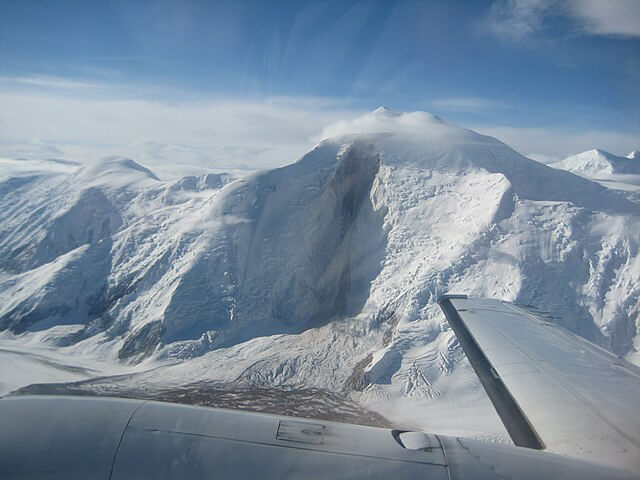
Elevation: 5020 m (16,470 ft)
Mountain Region: Saint Elias Mountains
Ascending to the sky, Mount Steele is the fifth-highest mountain in Canada and the tenth or eleventh-highest peak in North America. Its exact elevation remains uncertain, with commonly quoted figures ranging from 16,470 feet to 16,644 feet.
Complementing its grandeur, a lower southeast peak stretches to a height of approximately 14,100 feet, adding to the dramatic tableau of the mountainous landscape. The towering majesty of Mount Steele is a testament to the man from whom it derives its name. Sir Sam Steele was an emblematic figure of the North Northwest Police, entrusted with overseeing the force in the Yukon during the tumultuous period of the Klondike Gold Rush. Like its namesake, Mount Steele is an unbeatable feature in the rugged terrain, a silent guardian watching over the vast expanses of wilderness.
Its slopes and peaks are steeped in the rich history of Canada, providing a breathtaking backdrop to the narrative of a country forged through exploration and adventure.
12 Mount Blackburn

Elevation: 4996 m (16,390 ft)
Mountain Region: Wrangell Mountains
They were known in the Ahtna language as K’ats’i Tl’aadi; Mount Blackburn crowns the Wrangell Mountains of Alaska as their highest peak.
This mountain, the fifth-highest in the United States and the twelfth-highest in North America is a testament to the area’s geological past. As an old, eroded shield volcano, it is the second-highest in the U.S., following Mount Bona, and the fifth-highest in North America.
Mount Blackburn was named in 1885 by Lt. Henry T. Allen of the U.S. Army. He honoured Joseph Clay Stiles Blackburn, a U.S. senator from Kentucky who bestowed his name on the striking peak.
The mountain lies at the heart of Wrangell–St. Elias National Park, which boasts the title of the largest national park in the United States. The majestic Mount Blackburn is integral to this awe-inspiring, natural Alaskan panorama.
13 Mount Sanford
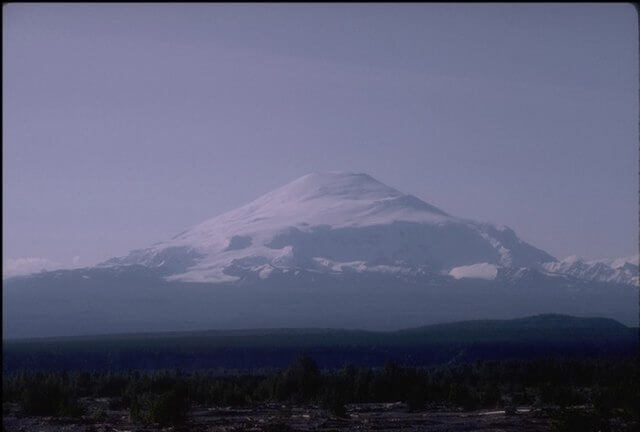
Elevation: 4949 m (16,237 ft)
Mountain Region: Wrangell Mountains
Anchoring the eastern Alaskan landscape near the Copper River, Mount Sanford, a shield volcano, holds its position in the Wrangell Volcanic Field. Recognized as the highest mountain in the United States, it is the third-highest volcano, surpassed only by Mount Bona and Mount Blackburn. A theatrical feature of Mount Sanford is its south face, positioned at the head of the Sanford Glacier.
This façade ascends an astonishing 8,000 feet within a mere one-mile span, creating one of the steepest gradients in North America. This natural marvel speaks to Alaska’s high-altitude terrains’ rugged, vertiginous beauty.
14 Mount Wood

Elevation: 4860 m (15,945) ft
Mountain Region: Saint Elias Mountains
Mount Wood, also known as Wood Peak, casts a towering presence as Canada’s highest mountain. Nestled within the breathtaking Kluane National Park and Reserve expanses, this natural wonder holds historical and geographical significance.
1900 surveyor James J. McArthur bestowed the peak with its name, honouring Zachary Taylor Wood. Wood, a figure from Canada’s storied past, served as an inspector for the North Northwest Police in Dawson during the fervour of the Klondike gold rush and eventually rose to commissioner.
Thus, Mount Wood embodies both the awe-inspiring wild majesty of Canada’s landscapes and a tribute to its rich heritage.
15 Mount Vancouver
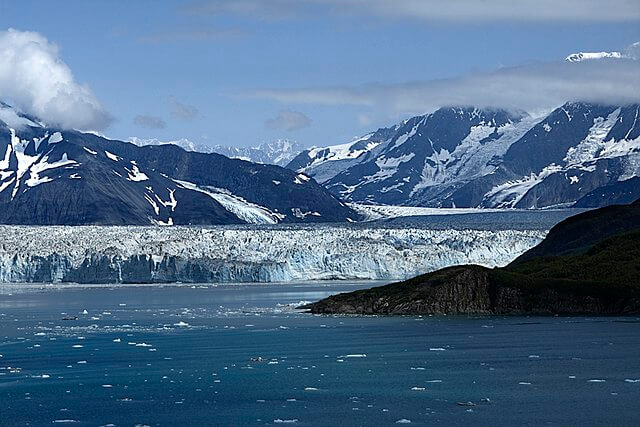
Elevation: 4812 m (15,787 ft)
Mountain Region: Saint Elias Mountains
Mount Vancouver, the fifteenth-highest peak in North America, uniquely straddles two countries and two national parks. On its southern flank, it graces the Glacier Bay National Park and Preserves at the apex of the Alaska panhandle.
At the same time, the northern side looms over the southwestern corner of Yukon, Canada, in Kluane National Park and Reserve. This remarkable mountain features three summits: the north, middle, and south, with the average being the least elevated. The south summit, Good Neighbor Peak, reaches an impressive 4,785 meters (15,699 feet) and shares the international border between the U.S. and Canada. It’s north meeting, however, slightly surpasses this elevation, peaking at 4,812 meters (15,787 feet).
Named by William Healey Dall in 1874, the mountain pays homage to George Vancouver, a renowned explorer who charted the southeast coast of Alaska between 1792 and 1794.
16 Mount Slaggard
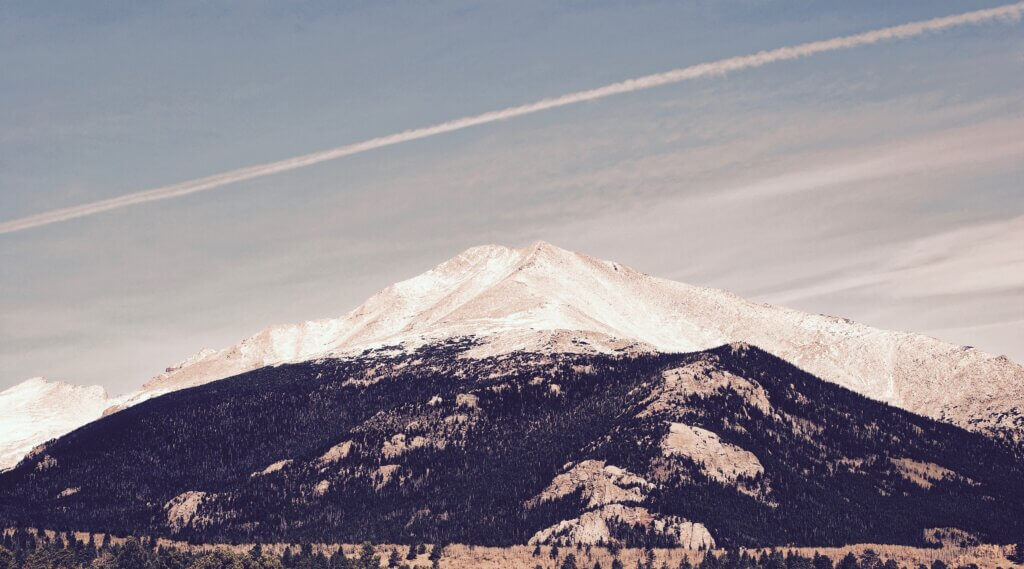
Elevation: 4742 m (15,558 ft)
Mountain Region: Saint Elias Mountains
Mount Slaggard, nestled deep within the Icefield Range, is Canada’s ninth-highest peak, rising to 4,742 meters. Its remoteness and frequent severe storms contribute to Canada’s status as one of its least-known significant peaks.
Notably less imposing than the notable peaks of the St. Elias range, it offers climbers a unique appeal. Its location was even more north and west than its higher counterparts, ensuring isolation that few peaks could match. Heavily glaciated, Mount Slaggard has three major ridge systems.
These are home to the main summit and three sub-summits. This includes the South Slaggard, which was first climbed in 1997. Situated within the extensive confines of Kluane National Park and Reserve, Mount Slaggard is a part of the formidable St. Elias Mountains, celebrated for their legendary storms and grandeur.
This peak was one of the last significant summits in the icefields to be ascended, not climbed until 1959. Most climbers undertake the challenge of the summit via the mountain’s eastern ridge. This is enticed by the opportunity to tread on untouched snow and experience a soothing alpine environment.
17 Nevado de Toluca

Elevation: 4690 m (15,387 ft)
Mountain Region: Cordillera Neovolcanica
Nevado de Toluca, a stratovolcano in central Mexico, is an impressive sight, the country’s fourth-highest peak. It sits roughly 80 kilometres west of Mexico City and near Toluca. Only the Pico de Orizaba, Popocatépetl, and Iztaccíhuatl outshine it in height.
The volcano’s prominence, however, extends beyond its elevation. Nevado de Toluca boasts diverse landscapes and geology. It’s recognized as a national park. This preserves its natural beauty. Future generations can thus appreciate it.
18 Mount Fairweather
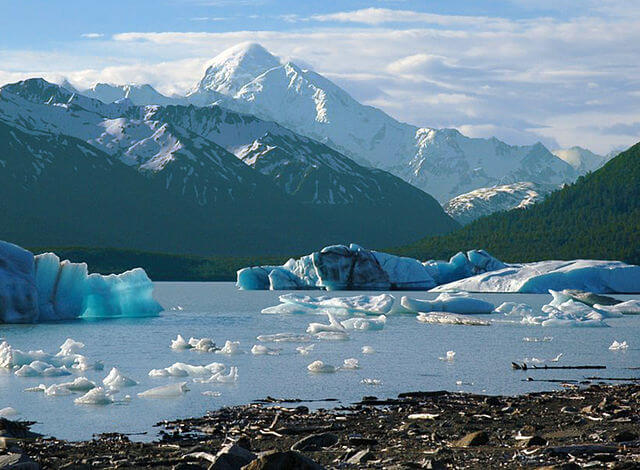
Elevation: 4671 m (15,325 ft)
Mountain Region: Saint Elias Mountains
Mount Fairweather is officially known as Fairweather Mountain in Canada. It is a towering emblem of British Columbia, the highest peak in the province at 4,653 meters (15,325 ft) above sea level. It stands a mere 20 kilometres (12 miles) from the Pacific Ocean. I
t sits on the U.S.-Canada border between Alaska and western British Columbia. Alaska’s Glacier Bay National Park and Preserve protect a significant portion of this majestic mountain’s summit. It also marks the border of Tatshenshini-Alsek Provincial Park in British Columbia, earning it the designation of Boundary Peak 164 or U.S./Canada Boundary Point #164.
The mountain owes its name to Captain James Cook, who, on May 3, 1778, was inspired by the unusually favourable weather conditions to dub it “Mount Fairweather”. Many languages have since translated this name, reflecting the mountain’s international renown. Its first known successful climb wasn’t until 1931, accomplished by the daring duo of Allen Carpé and Terris Moore.
The allure of Mount Fairweather continues to captivate modern mountaineers, adventurers, and nature enthusiasts.
19 Mount Hubbard
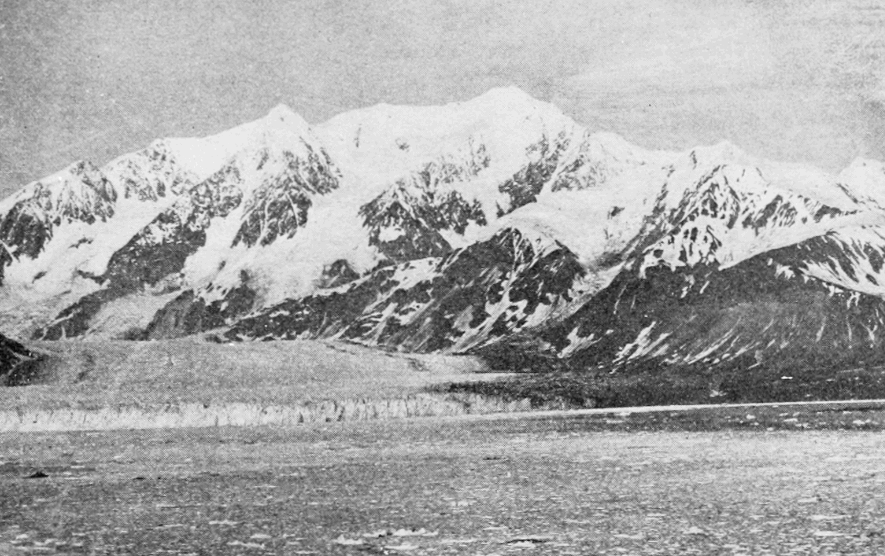
Elevation: 4557 m (14,951 ft)
Mountain Region: Saint Elias Mountains
Mount Hubbard, a prominent feature of the Saint Elias Range, straddles the border between Alaska and Yukon. This international giant has roots in the Wrangell–St—Elias National Park in the United States and Kluane National Park and Reserve in Canada.
Moreover, the mountain was named in honour of Gardiner Greene Hubbard, the first president of the National Geographic Society. Geologist Israel Russell accomplished this in 1890, highlighting its noteworthy geographical prominence. Mount Hubbard is the pinnacle of an enormous massif, including Mount Alverstone and Mount Kennedy. Mount Hubbard’s stature is unmistakable, with titles: eighth-highest peak in the U.S. and the twelfth-highest in Canada. It exhibits a dramatic rise above the surrounding terrain.
Therefore, the western face ascends 7,500 feet (2,300 meters) from the Alverstone Glacier in a mere 2 miles (3.2 kilometres). Moreover, it towers 11,000 feet (3,350 m) above the Hubbard Glacier in just 7 miles (11.3 km). Mount Hubbard is slightly more than 20 miles (32 km) from the tidewaters of Disenchantment Bay.
Despite imposing Western aspects, the mountain’s eastern flank offers adventurers a non-technical route to the summit. This demonstrates that even the mightiest of peaks can provide approachable challenges.
20 Mount Bear
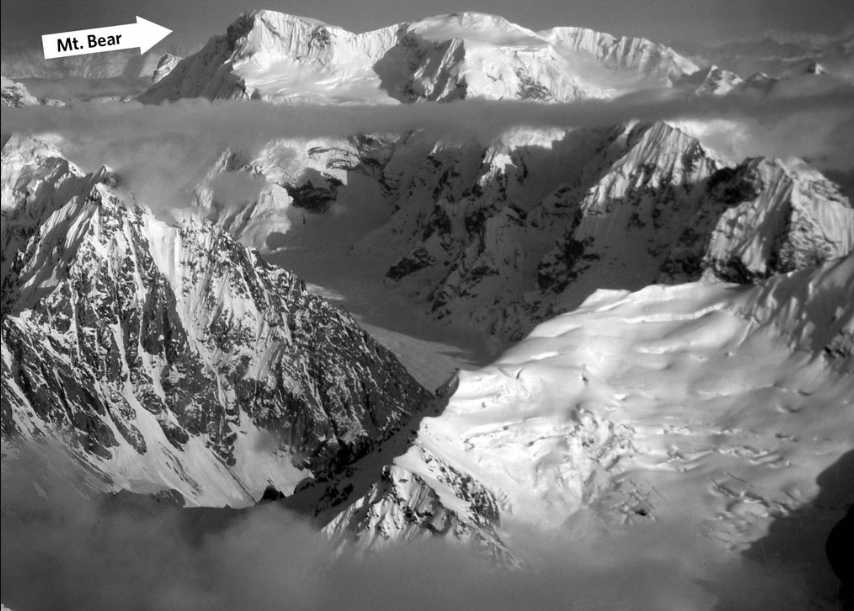
Elevation: 4520 m (14,831 ft)
Mountain Region: Saint Elias Mountains
Located in the Saint Elias Mountains, Mount Bear sits in Alaska’s Wrangell-Saint Elias National Park. It’s 4 miles west of the Yukon border. The Barnard Glacier flows from its southwest, while the Klutlan Glacier sits north. Mount Bear ranks among North America’s top 20 peaks and is a “fourteener”.
While its altitude is impressive, Mount Bear remains an unsung hero among the North American peaks. Overshadowed by more renowned mountains like Mount Bona, Mount Lucania and Mount Logan, it often goes unvisited. Yet, on a relative scale, Mount Bear is a formidable presence.
The steep fall from its summit to the Barnard Glacier is a staggering 8,000 feet (2,440 m) over less than 5 miles (8 km). It also rises an impressive 10,000 feet (3,050 m) within a 12-mile (19.3 km) radius. This noteworthy vertical prominence underscores Mount Bear’s silent majesty amidst the grand tapestry of North American mountains.
Next 20 Tallest Mountains in North America
| No. | Mountain Name | Elevation (meters) | Elevation (feet) | Mountain Region |
|---|---|---|---|---|
| 21 | Mount Walsh | 4506 | 14,783 | Saint Elias Mountains |
| 22 | Mount Hunter | 4442 | 14,573 | Alaska Range |
| 23 | Malinche (volcano) | 4430 | 14,534 | Trans-Mexican Volcanic Belt |
| 24 | Mount Whitney | 4421 | 14,505 | Sierra Nevada |
| 25 | Mount Alverstone | 4420 | 14,500 | Saint Elias Mountains |
| 26 | University Peak | 4410 | 14,470 | Saint Elias Mountains |
| 27 | Mount Elbert | 4401.2 | 14,440 | Sawatch Range |
| 28 | Mount Massive | 4398 | 14,428 | Sawatch Range |
| 29 | Mount Harvard | 4395.6 | 14,421 | Sawatch Range |
| 30 | Mount Rainier | 4394 | 14,417 | Cascade Range |
| 31 | Mount Williamson | 4383 | 14,379 | Sierra Nevada |
| 32 | McArthur Peak | 4380 | 14,370 | Saint Elias Mountains |
| 33 | Blanca Peak | 4374 | 14,351 | Sangre de Cristo Mountains |
| 34 | La Plata Peak | 4372 | 14,343 | Sawatch Range |
| 35 | Uncompahgre Peak | 4365 | 14,321 | San Juan Mountains |
| 36 | Crestone Peak | 4359 | 14,300 | Sangre de Cristo Range |
| 37 | Mount Lincoln | 4356.5 | 14,293 | Mosquito Range |
| 38 | Castle Peak | 4352.2 | 14,279 | Elk Mountains |
| 39 | Grays Peak | 4352 | 14,278 | Front Range |
| 40 | Mount Antero | 4351.4 | 14,276 | Sawatch Range |

